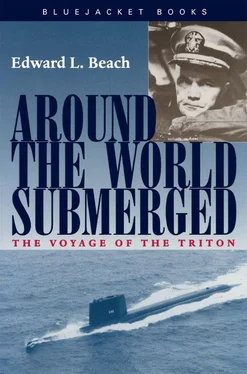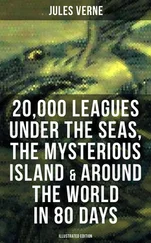A recently developed device was being tried out this morning. One of our periscopes featured a new development of the Kollmorgen Optical Company by which the altitude of celestial bodies could be observed as accurately through a periscope as with the trusted sextant. Until recent years, submarines were navigated in the same manner as any other ship, and to get their sights they had to be on the surface. Since nonnuclear subs have to be on the surface every day for long periods anyway, either to charge their batteries or to run at the high speeds which they can’t make while submerged, taking a sight presented no special problem—although I can recall several times during the war when I had to lash myself to a heaving, wet bridge and protect my sextant between sights with a sou’wester hat. The snorkel did not completely release the submarine from the surface, since air was still needed for the diesel engines, but it enabled the engines to be run at periscope depth, and this in turn focused attention upon the need for a new way of shooting stars. With the nuclear submarine’s greatly increased radius of action, taking sights through a periscope became a necessity. Many special periscopes have been built for the purpose, mainly by the Kollmorgen Optical Company, and perhaps a certain Lieutenant Fred Kollmorgen’s tour in the USS Skate has had something to do with this.
Two of the latest devices under development we did not yet have in full measure: a really effective way of generating oxygen from the sea, and a dependable means of determining position by gyroscopic instrumentation without celestial observations. Intensive effort had gone into the research and design necessary for a workable and safe oxygen generator for submarine use, and pilot models destined for the Polaris submarines were already being produced. All nuclear submarines carry stored oxygen, compressed in huge steel bottles. Having been completed too soon to have an oxygen generator, Triton also carried an extra supply of large “oxygen candles,” similar to those used by miners in some of our country’s deep pits. When ignited, these compounds of sodium, barium, and iron give off intense heat, some smoke, and lots of oxygen over and above that needed to support their own combustion. Appropriately, they must be set off in an “oxygen furnace,” and lest anyone see in them an answer to some personal or industrial need for oxygen, let him be warned that they are tricky and difficult to handle safely.
As for the gyroscopic navigation system, we had a pilot model for evaluation. Called “ship inertial navigation system,” or SINS, it was designed to measure earth rotation and other normally undetectable forces by means of extra-precise gyroscopes. Automatically it calculates latitude and longitude, and the results appear on dials on the face of a black box. Many a navigator, plagued by fog and bad weather, has thought of inventing such a gadget. As a midshipman at the Naval Academy, I had designed one, too, and, theoretically speaking, it might have worked. Now, many years later, similar computers are used in our ballistic missiles and two of them, “robbed” from missiles, had been placed aboard Nautilus and Skate for their polar explorations. One of our missions on this cruise was to give our SINS a thorough checkout, continually comparing its computed positions to our own best-determined fixes. When SINS is perfected, the only use a navigator will have for the stars will be for an occasional check—and to preserve one of the ancient and romantic arts of the seaman. This device will someday spell the end of that respected professional, the navigator of the open sea.
After exactly an hour of ventilating the ship, we pulled down the periscopes, shut the induction valves, and went deep again. In Triton, the “inboard hull ventilation valve”—our back-up in case the hydraulically operated outboard valve fails—is right outside the Captain’s stateroom, and is shut on diving by the duty wardroom steward. But despite Chief Steward William (“Joe”) Green’s extreme brawn, he could not shut the inboard hull ventilation valve. When I came aft from the conning tower, I found him grunting and heaving, tugging with bulging muscles at the long-handled operating mechanism. Before going deep, the ship had been checked tight with hydraulic and electric outboard valves both properly shut; thus, there was never any danger of flooding, but this critically important valve could not be closed no matter how hard we tried.
Submarines always have a “backup” for everything, so that a single casualty should not, of itself, spell catastrophe; but one of the reasons why the Squalus sank was that when her hydraulic air valve failed to shut, two hand-operated valves in the same tremendous air pipe also could not be shut. About a third of her crew drowned in the flooded after compartments and the rest were rescued through a newly developed diving rescue chamber. Squalus herself remained on the bottom for months until she could be raised and salvaged. It is perhaps appropriate to note that within a few weeks of the Squalus incident, the British and Japanese navies suffered similar submarine disasters, and in neither of those cases were any personnel rescued.
Triton ’s design featured, among other things, a large, heavy steel plate in the overhead of the “officer’s country”—also right outside my room—which could be removed for inspection of the induction piping. The job took several hours, and the men working on the plate were so cramped for space that they could barely swing a wrench. But the plate finally came off and we found a smashed and rusted flashlight which had lodged in the induction valve seat, its crushed case testifying to the strength in “Joe” Green’s arms. Some careless workman had probably left it there months ago.
Who knows but what some other careless workman, or perhaps a survivor of Squalus’ crew, may even today carry in his soul the secret knowledge of why a similar valve could not be shut—or unaccountably swung open again—on that dreadful day?
Shortly before noon, Will Adams sought me out, carefully closing the door behind my stateroom curtain before speaking. “Captain, when do you plan to make the announcement about our trip?” he asked.
“Sometime tomorrow,” I told him. “What’s the hurry?”
“The whole crew is on edge, sir,” Will said. “They know we’re well clear of Nantucket. We should have headed northeast long ago, if we’re really going up north. Continuing on down this way is a giveaway that something is up.” Will paused. “Is there any special reason for not passing the word out now?”
“The only reason left,” I said, “is that if anything were to go wrong we might still have to turn back; and I wouldn’t want to come into port and have the word get out about this operation.”
Will nodded. “Yes, sir,” he said, “but that could happen and wreck the trip any time. The crew knows that something is up and are making up all sorts of rumors.”
“There’s more, too,” I said. “For the time being, if we did have to go back, there would still be a chance to fix whatever is wrong and, by speeding up a little, make the trip on schedule anyway.”
Will nodded, not entirely convinced that staying on schedule was a matter of so much importance. He was my right-hand man, but I couldn’t tell him the one thing which I knew would change his mind.
There was a strain among all the officers, too. I felt it the moment Will and I joined them for lunch. In the wardroom, we resolutely kept the conversation away from this subject, but as the afternoon wore on I realized that regard for the feelings of our men required that they be informed earlier than I had originally intended. This being our first complete day at sea, after an extremely strenuous period of preparation, Will had scheduled no drills. Perhaps this was a mistake; it gave everyone more leisure to think about our prospects. In the meantime, our glorious ship was throwing the miles astern in joyous abandon. Shakedown cruise or no, she was on her way, and every mile made me all the more certain that here, at last, was a ship which would repay with interest all the heartbreak and unfulfilled promise of Trigger II.
Читать дальше












